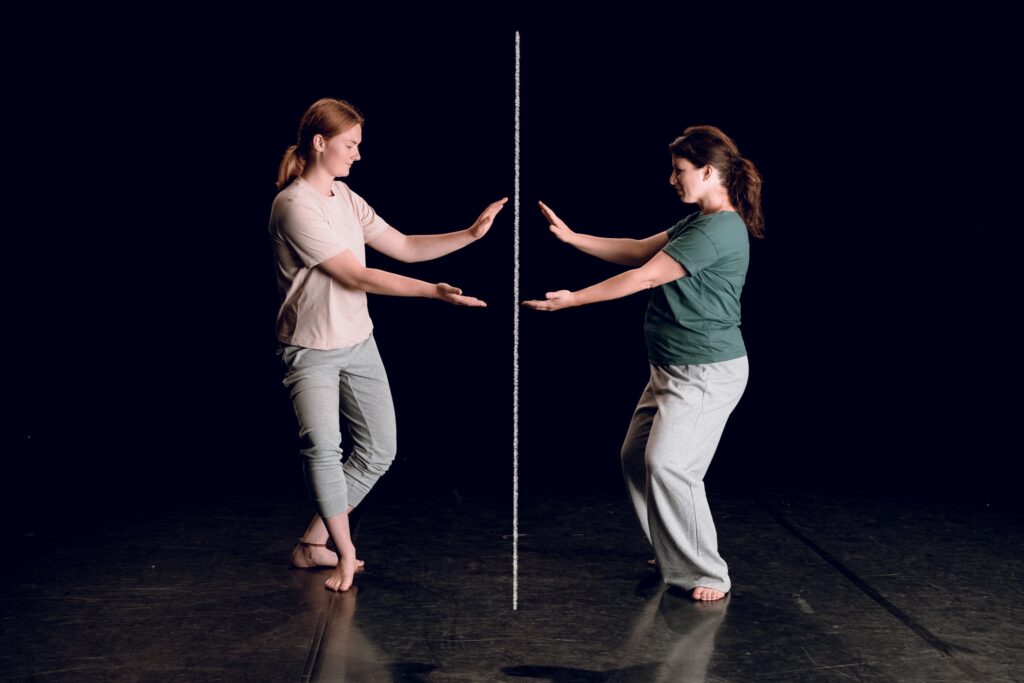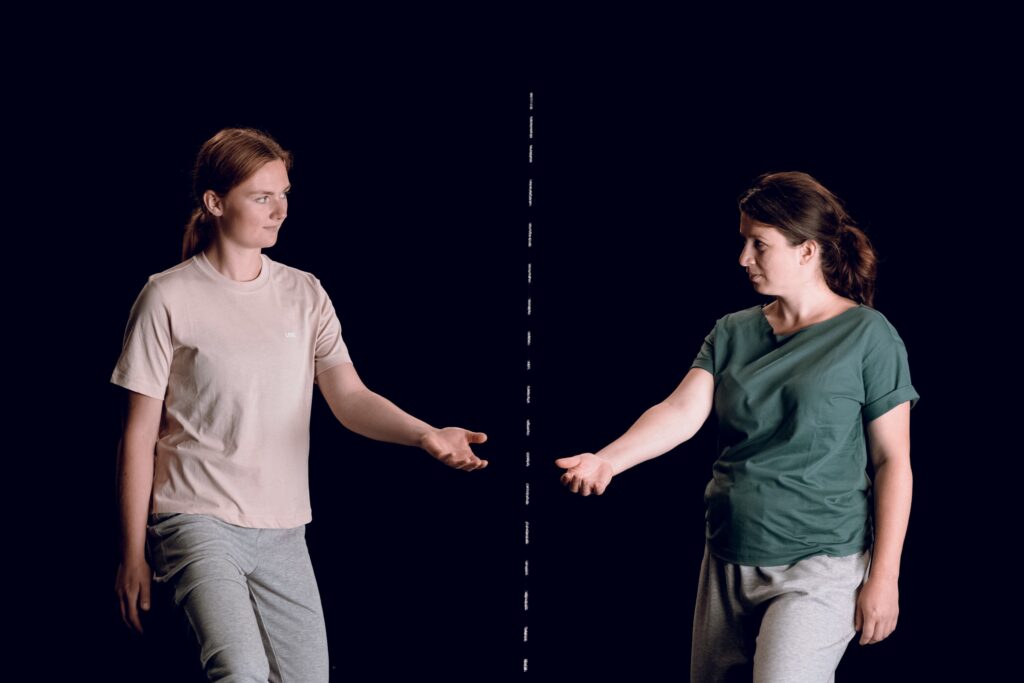As the group members become familiar with each other and the basic atmosphere of trust is established, it is time to break into couples and experience one-to-one contact.
The following games serve as a pre-step for “interviewing each other”, which is the basic tool for discovering authentic stories as a source for further text work.
A) Mirroring
1. One leader and one mirror: This game is usually familiar to most of the participants. Nevertheless, you need to describe the rules of your version. Tell the group to pick a partner and find a place in the room as a couple. They should have enough space around them to move safely. Members of couples should stand with around 80 cm distance between them. Each couple should decide which one of the two wants to be the “mirror”. This person will follow the other one. Now tell them to stand in the neutral position. No movements, no gestures, any small change can be visible. The leading person starts to move with any part of his/her body in a way that it is possible for the partner to simultaneously mirror those movements. If any party in the couple notices that the movements cannot be followed precisely, he/she should give a silent note to the other: “You are moving too fast”, “You are making too many movements at the same time”, or “The mirror is faster than the leader”. They should keep experimenting. When they reach the level at which they move almost simultaneously, they can test their partner’s attention and speed up. They should work with the details and be very precise and particular about each element of their movements. Encourage them to use different parts of their bodies such as fingertips, tongue, elbows. Tell them to keep exploring and not to forget to breathe. Speaking is not allowed. (Time range can be 5 – 10 min, or more if you think the group needs it.)

Then members of the couples switch roles. When both partners experience leading and mirroring, they can give short feedback to each other. Depending on the situation you can challenge your participants to get another partner and do the same thing. Then do a group-feedback session and carefully listen to the discoveries of the participants.
2. Leaders and mirrors at the same time: Ask participants to find another partner.Now both will be leading and mirroring at the same time. An external observer should not recognize who is the leader and who is the mirror. Try this for 5 – 10 minutes. Do a short feedback session within each couple, then in the whole group.
What we are exploring:
- Respect for the partner
- Differences in bodies, speed, timing, personal approaches and decisions
- The ability to work with precision
- Magic of copying someone’s movements and being copied
- Working simultaneously
- Obstacle: Leading or following being the only communication channel between couples
B) Thread exercises (from Min Tanaka’s Body Weather training): This game is built on similar principles as Mirroring. The starting point is the same: the neutral position. Two people should be standing around 80 cm apart. Tell the couples to imagine that the only connection between them is an imaginary thread. It should have a constant length, always stretched. The thread must always stay parallel to the floor.
1. One leader and one follower: Ask the couples to decide who will lead and who will follow. Tell them to start very slowly so that their partners can follow. In case of “turbulence” in communication, they can give each other a silent note such as: “You are moving too fast”, “Don’t push me”, or “I’m the leader.” The thread is the only communication between the couples. No speaking. Then tell them to start moving in the space as a couple. Leading his/her partner through the space, the leader must be aware of other couples, so no one gets hurt. As the game proceeds they can be braver regarding the speed and the height of the thread. While playing this game, participants should be as precise as possible. (5 – 10 minutes)
After a short feedback session within couples, tell them to switch roles and do the same thing. Then do a group feedback session.
2. Leaders and followers at the same time: Tell the participants to do the same exercise with both leading and following at the same time. Again, an external observer should not recognize who is the leader and who is the follower. They should be as precise as possible (5 – 10 minutes). Tell them to give feedback to each other, then do a group feedback session.

What we are exploring:
- Basic language for further work in couples
- Our ability to stay focused
- Obstacle: The thread being the only communication channel between couples